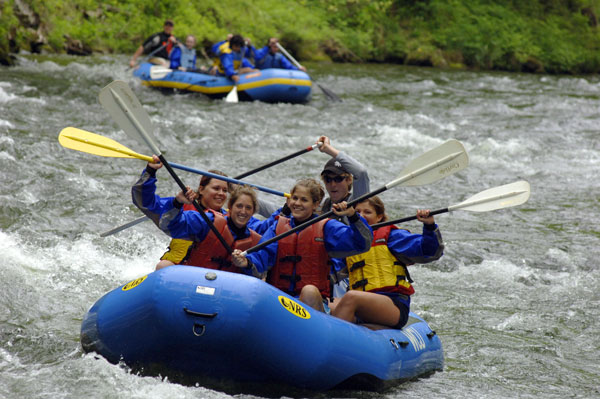
The Nantahala Outdoor Center has quickly become one of the area’s most popular and recognized attractions. It provides a combination of excitement, escape, and activity. Add to this the timeless lure of the beauty of Western North Carolina and visitors are able to experience a truly spectacular part of the region’s mountain heritage.
“Any job that allows me to be on that environment is perfect as far as I’m concerned”
Multimedia:
Below is the Digital Heritage Moment as broadcast on the radio:
[audio:http://dh.wcu.edu/wp-content/uploads/2010/10/Nanthl-60-mix.mp3|titles=Nanthl 60 mix]
Nantahala Outdoor center essay
Essay by Timothy N. Osment, History M.A., WCU 2008
What is it about a fast-flowing river that tempts people seemingly to abandon common sense, climb into a small man-made float, and defy nature to go hurtling down chilling whitewater rapids?
People have been enjoying “whitewatering” in western North Carolina for many years. The activity has grown in popularity and even evolved into an Olympic sport. A few short years ago, whitewatering meant floating down the Nantahala, Deep Creek, or the Tuckasegee on an over-blown, well-worn, discarded tire tube. That method of transport is still popular, but it is no longer exclusive. Canoes, inflatable rafts, and high-tech kayaks have joined in the fun. Each has its own lure and attraction. Large, inflatable rafts are the most recent addition to the sport of whitewatering.
They are usually operated by tour companies and can carry ten or more people. Occupants wear helmets, life-vests, and are instructed in proper whitewater technique and etiquette. A river guide pilots the craft. This choice for a “river-run” is great fun for both amateurs and experts. “Tubers” choose a simpler form of river activity. With a swimsuit, t-shirt, and an old pair of sneakers, these relaxed floaters enjoy the beautiful environment while dodging the occasional river rock. Tubers maximize their fun while minimizing their investment in both time and money. Other enthusiasts choose canoes or kayaks for their whitewater adventures.
The history of canoes dates back thousands of years, long before Europeans landed in the New World. Kayaks are a fairly recent addition to our mountain region. The kayak was first created by the Inuit, an Artic people. They were made from wooden frames covered in sealskin. They included a small hole in the middle of the craft for the user to sit in and were primarily used for hunting. Some were short and wide with a large storage capacity; they were stable and easy to use. Others were built long and narrow, designed to be fast and seaworthy. European settlers began to use manmade fabrics instead of beaver, muskrat, and otter. In the 1950s, fiberglass was introduced. It was used until the 1980s when plastic became the choice of manufacturers. Today’s kayaks are sturdy, light, and very versatile. Three main distinctions separate canoes and kayaks: A kayak is a decked boat, while a canoe is not. Kayakers sit flat with their legs extended under the deck and their upper body rising from a central hole in the deck. On the other hand, a canoer usually kneel in the boat. A third difference is the paddle. A canoe utilizes a shorter paddle with a blade on one end only, a shortened version of a row boat’s oar. The kayak uses a longer paddle with blades at both ends. Now that we know something of our flotation options, where can we apply this knowledge?
One place is the Nantahala River in the mountains of western North Carolina. Located in the Nantahala National Forest, it flows from Macon County into Swain County. The nine-mile long Nantahala River Gorge is managed by the USDA Forest Service. The Nantahala’s designation as a recreation site is a by-product of a power-generation project began by the Tennessee Valley Authority in the 1940s. Today, thousands of whitewater enthusiasts enjoy the river while thousands of mountain residents benefit from the electricity generated by its flowing waters. Along its banks is located one of the nation’s best known whitewater companies, the Nantahala Outdoor Center (NOC).
The NOC was formally organized in 1972, when founders Payson and Aurelia Kennedy and Horace Holden took over the old Tote N’ Tarry motel. Additionally, they opened a small rafting company on the banks of the Nantahala River. The popularity of their guided raft tours soon exceeded even their expectations. Word spread throughout the region, and the NOC was on its way. That same year, whitewater kayaking made its Olympic debut in Munich, Germany. Former NOC president John Burton was on the U.S. Olympic team that year. His teammate, Angus Morrison, is currently a head guide at the NOC and was also on the 1976 and 1980 Olympic teams. Six other Olympians have trained on the Nantahala River. Currently, the NOC operates an industry-renowned canoe and kayak paddling school. Here they help professionals hone their skills while teaching amateurs the basics of whitewater paddling.
Within easy driving distance of Asheville, Atlanta, Charlotte, and Knoxville, today’s NOC is more popular and diverse than ever. Currently the staff leads whitewater rafting trips on seven Southeastern rivers, including the Chattooga, Cheoah, French Broad, Nantahala, Nolichucky, Ocoee, and Pigeon. Besides whitewatering, the NOC offers visitors a variety of optional recreational activities that include mountain biking, picnicking, trout fishing, hiking, camping, photography, and ropes courses. A recent addition is adventure travel. Planned expeditions send NOC staff and participants to Central and South America to enjoy outdoor activities and challenges in a variety of landscape environments.
During the summer of 2006, Good Morning America and National Geographic Adventures released a list of the nation’s ten top “Vacations with a Splash.” The Nantahala Outdoor Center earned the Number One spot. The NOC received this designation due to the reputation and skill of their staff, their variety of adventure opportunities, and the quality of their resort facilities. Undoubtedly, the NOC’s location – nestled in the lush, Southern Appalachian Mountains – contributed to their recognition.
As a pioneer in outdoor adventure recreation, the NOC has something for just about everyone. A good starting point for first-time visitors is a run down the Nantahala River aboard a guided raft. The center boasts about their staff, “Their jokes may be corny, but their knowledge and talent are unparalleled.” After an initial whitewater experience individuals can move on to other exciting activities or simply relax and enjoy the splendor of the mountain scenery.
Contact information
Nantahala Outdoor Center
13077 Highway 19 W
Bryson City, NC 28713-9165
phone: 888-905-7328 or 828-488-2176
online: http://www.noc.com/
For more information please see:
- Carolina Whitewater: A Canoeists Guide to the Western Carolinas by Bob & David Benner, 2005.
- A Second Helping: A Review of Kayak Basics (videorecording) presented by the Nantahala Outdoor Center; producer Carl Wetzler, 1987.
- Appalachian Whitewater: the Premier Canoeing and Kayaking Streams of Alabama, Georgia, Kentucky, Maryland, North Carolina, South Carolina, Tennessee, Virginia, and West Virginia by Bob Sehlinger, 4th edition, 2000.

